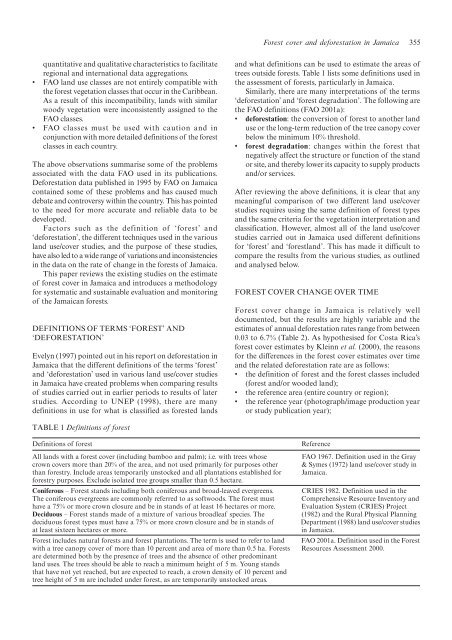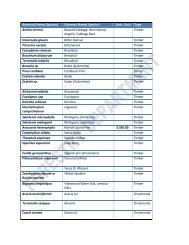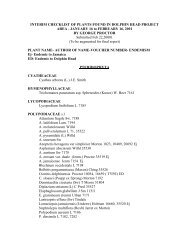Forest cover and deforestation in Jamaica - the Forestry Department
Forest cover and deforestation in Jamaica - the Forestry Department
Forest cover and deforestation in Jamaica - the Forestry Department
You also want an ePaper? Increase the reach of your titles
YUMPU automatically turns print PDFs into web optimized ePapers that Google loves.
quantitative <strong>and</strong> qualitative characteristics to facilitate<br />
regional <strong>and</strong> <strong>in</strong>ternational data aggregations.<br />
• FAO l<strong>and</strong> use classes are not entirely compatible with<br />
<strong>the</strong> forest vegetation classes that occur <strong>in</strong> <strong>the</strong> Caribbean.<br />
As a result of this <strong>in</strong>compatibility, l<strong>and</strong>s with similar<br />
woody vegetation were <strong>in</strong>consistently assigned to <strong>the</strong><br />
FAO classes.<br />
• FAO classes must be used with caution <strong>and</strong> <strong>in</strong><br />
conjunction with more detailed def<strong>in</strong>itions of <strong>the</strong> forest<br />
classes <strong>in</strong> each country.<br />
The above observations summarise some of <strong>the</strong> problems<br />
associated with <strong>the</strong> data FAO used <strong>in</strong> its publications.<br />
Deforestation data published <strong>in</strong> 1995 by FAO on <strong>Jamaica</strong><br />
conta<strong>in</strong>ed some of <strong>the</strong>se problems <strong>and</strong> has caused much<br />
debate <strong>and</strong> controversy with<strong>in</strong> <strong>the</strong> country. This has po<strong>in</strong>ted<br />
to <strong>the</strong> need for more accurate <strong>and</strong> reliable data to be<br />
developed.<br />
Factors such as <strong>the</strong> def<strong>in</strong>ition of ‘forest’ <strong>and</strong><br />
‘<strong>deforestation</strong>’, <strong>the</strong> different techniques used <strong>in</strong> <strong>the</strong> various<br />
l<strong>and</strong> use/<strong>cover</strong> studies, <strong>and</strong> <strong>the</strong> purpose of <strong>the</strong>se studies,<br />
have also led to a wide range of variations <strong>and</strong> <strong>in</strong>consistencies<br />
<strong>in</strong> <strong>the</strong> data on <strong>the</strong> rate of change <strong>in</strong> <strong>the</strong> forests of <strong>Jamaica</strong>.<br />
This paper reviews <strong>the</strong> exist<strong>in</strong>g studies on <strong>the</strong> estimate<br />
of forest <strong>cover</strong> <strong>in</strong> <strong>Jamaica</strong> <strong>and</strong> <strong>in</strong>troduces a methodology<br />
for systematic <strong>and</strong> susta<strong>in</strong>able evaluation <strong>and</strong> monitor<strong>in</strong>g<br />
of <strong>the</strong> <strong>Jamaica</strong>n forests.<br />
DEFINITIONS OF TERMS ‘FOREST’ AND<br />
‘DEFORESTATION’<br />
Evelyn (1997) po<strong>in</strong>ted out <strong>in</strong> his report on <strong>deforestation</strong> <strong>in</strong><br />
<strong>Jamaica</strong> that <strong>the</strong> different def<strong>in</strong>itions of <strong>the</strong> terms ‘forest’<br />
<strong>and</strong> ‘<strong>deforestation</strong>’ used <strong>in</strong> various l<strong>and</strong> use/<strong>cover</strong> studies<br />
<strong>in</strong> <strong>Jamaica</strong> have created problems when compar<strong>in</strong>g results<br />
of studies carried out <strong>in</strong> earlier periods to results of later<br />
studies. Accord<strong>in</strong>g to UNEP (1998), <strong>the</strong>re are many<br />
def<strong>in</strong>itions <strong>in</strong> use for what is classified as forested l<strong>and</strong>s<br />
TABLE 1 Def<strong>in</strong>itions of forest<br />
<strong>Forest</strong> <strong>cover</strong> <strong>and</strong> <strong>deforestation</strong> <strong>in</strong> <strong>Jamaica</strong> 355<br />
<strong>and</strong> what def<strong>in</strong>itions can be used to estimate <strong>the</strong> areas of<br />
trees outside forests. Table 1 lists some def<strong>in</strong>itions used <strong>in</strong><br />
<strong>the</strong> assessment of forests, particularly <strong>in</strong> <strong>Jamaica</strong>.<br />
Similarly, <strong>the</strong>re are many <strong>in</strong>terpretations of <strong>the</strong> terms<br />
‘<strong>deforestation</strong>’ <strong>and</strong> ‘forest degradation’. The follow<strong>in</strong>g are<br />
<strong>the</strong> FAO def<strong>in</strong>itions (FAO 2001a):<br />
• <strong>deforestation</strong>: <strong>the</strong> conversion of forest to ano<strong>the</strong>r l<strong>and</strong><br />
use or <strong>the</strong> long-term reduction of <strong>the</strong> tree canopy <strong>cover</strong><br />
below <strong>the</strong> m<strong>in</strong>imum 10% threshold.<br />
• forest degradation: changes with<strong>in</strong> <strong>the</strong> forest that<br />
negatively affect <strong>the</strong> structure or function of <strong>the</strong> st<strong>and</strong><br />
or site, <strong>and</strong> <strong>the</strong>reby lower its capacity to supply products<br />
<strong>and</strong>/or services.<br />
After review<strong>in</strong>g <strong>the</strong> above def<strong>in</strong>itions, it is clear that any<br />
mean<strong>in</strong>gful comparison of two different l<strong>and</strong> use/<strong>cover</strong><br />
studies requires us<strong>in</strong>g <strong>the</strong> same def<strong>in</strong>ition of forest types<br />
<strong>and</strong> <strong>the</strong> same criteria for <strong>the</strong> vegetation <strong>in</strong>terpretation <strong>and</strong><br />
classification. However, almost all of <strong>the</strong> l<strong>and</strong> use/<strong>cover</strong><br />
studies carried out <strong>in</strong> <strong>Jamaica</strong> used different def<strong>in</strong>itions<br />
for ‘forest’ <strong>and</strong> ‘forestl<strong>and</strong>’. This has made it difficult to<br />
compare <strong>the</strong> results from <strong>the</strong> various studies, as outl<strong>in</strong>ed<br />
<strong>and</strong> analysed below.<br />
FOREST COVER CHANGE OVER TIME<br />
<strong>Forest</strong> <strong>cover</strong> change <strong>in</strong> <strong>Jamaica</strong> is relatively well<br />
documented, but <strong>the</strong> results are highly variable <strong>and</strong> <strong>the</strong><br />
estimates of annual <strong>deforestation</strong> rates range from between<br />
0.03 to 6.7% (Table 2). As hypo<strong>the</strong>sised for Costa Rica’s<br />
forest <strong>cover</strong> estimates by Kle<strong>in</strong>n et al. (2000), <strong>the</strong> reasons<br />
for <strong>the</strong> differences <strong>in</strong> <strong>the</strong> forest <strong>cover</strong> estimates over time<br />
<strong>and</strong> <strong>the</strong> related <strong>deforestation</strong> rate are as follows:<br />
• <strong>the</strong> def<strong>in</strong>ition of forest <strong>and</strong> <strong>the</strong> forest classes <strong>in</strong>cluded<br />
(forest <strong>and</strong>/or wooded l<strong>and</strong>);<br />
• <strong>the</strong> reference area (entire country or region);<br />
• <strong>the</strong> reference year (photograph/image production year<br />
or study publication year);<br />
Def<strong>in</strong>itions of forest Reference<br />
All l<strong>and</strong>s with a forest <strong>cover</strong> (<strong>in</strong>clud<strong>in</strong>g bamboo <strong>and</strong> palm); i.e. with trees whose FAO 1967. Def<strong>in</strong>ition used <strong>in</strong> <strong>the</strong> Gray<br />
crown <strong>cover</strong>s more than 20% of <strong>the</strong> area, <strong>and</strong> not used primarily for purposes o<strong>the</strong>r & Symes (1972) l<strong>and</strong> use/<strong>cover</strong> study <strong>in</strong><br />
than forestry. Include areas temporarily unstocked <strong>and</strong> all plantations established for<br />
forestry purposes. Exclude isolated tree groups smaller than 0.5 hectare.<br />
<strong>Jamaica</strong>.<br />
Coniferous – <strong>Forest</strong> st<strong>and</strong>s <strong>in</strong>clud<strong>in</strong>g both coniferous <strong>and</strong> broad-leaved evergreens. CRIES 1982. Def<strong>in</strong>ition used <strong>in</strong> <strong>the</strong><br />
The coniferous evergreens are commonly referred to as softwoods. The forest must Comprehensive Resource Inventory <strong>and</strong><br />
have a 75% or more crown closure <strong>and</strong> be <strong>in</strong> st<strong>and</strong>s of at least 16 hectares or more. Evaluation System (CRIES) Project<br />
Deciduous – <strong>Forest</strong> st<strong>and</strong>s made of a mixture of various broadleaf species. The (1982) <strong>and</strong> <strong>the</strong> Rural Physical Plann<strong>in</strong>g<br />
deciduous forest types must have a 75% or more crown closure <strong>and</strong> be <strong>in</strong> st<strong>and</strong>s of <strong>Department</strong> (1988) l<strong>and</strong> use/<strong>cover</strong> studies<br />
at least sixteen hectares or more. <strong>in</strong> <strong>Jamaica</strong>.<br />
<strong>Forest</strong> <strong>in</strong>cludes natural forests <strong>and</strong> forest plantations. The term is used to refer to l<strong>and</strong> FAO 2001a. Def<strong>in</strong>ition used <strong>in</strong> <strong>the</strong> <strong>Forest</strong><br />
with a tree canopy <strong>cover</strong> of more than 10 percent <strong>and</strong> area of more than 0.5 ha. <strong>Forest</strong>s<br />
are determ<strong>in</strong>ed both by <strong>the</strong> presence of trees <strong>and</strong> <strong>the</strong> absence of o<strong>the</strong>r predom<strong>in</strong>ant<br />
l<strong>and</strong> uses. The trees should be able to reach a m<strong>in</strong>imum height of 5 m. Young st<strong>and</strong>s<br />
that have not yet reached, but are expected to reach, a crown density of 10 percent <strong>and</strong><br />
tree height of 5 m are <strong>in</strong>cluded under forest, as are temporarily unstocked areas.<br />
Resources Assessment 2000.




